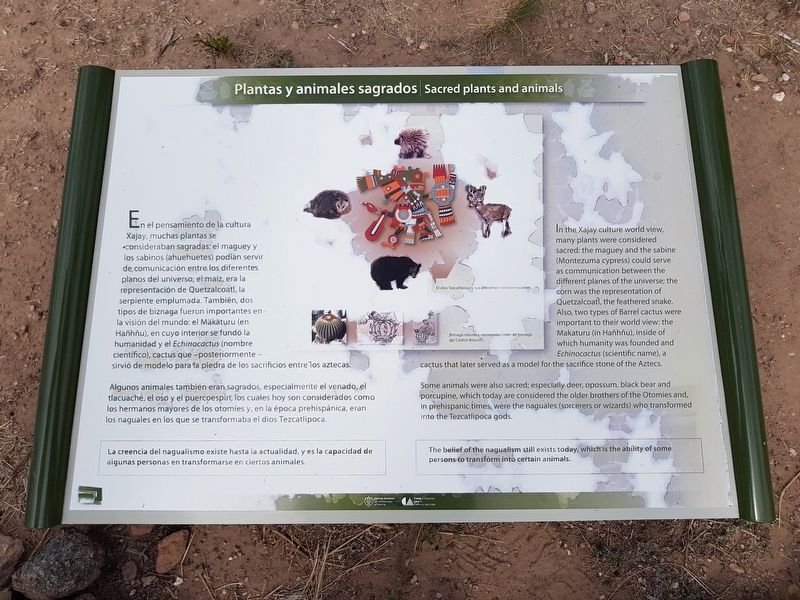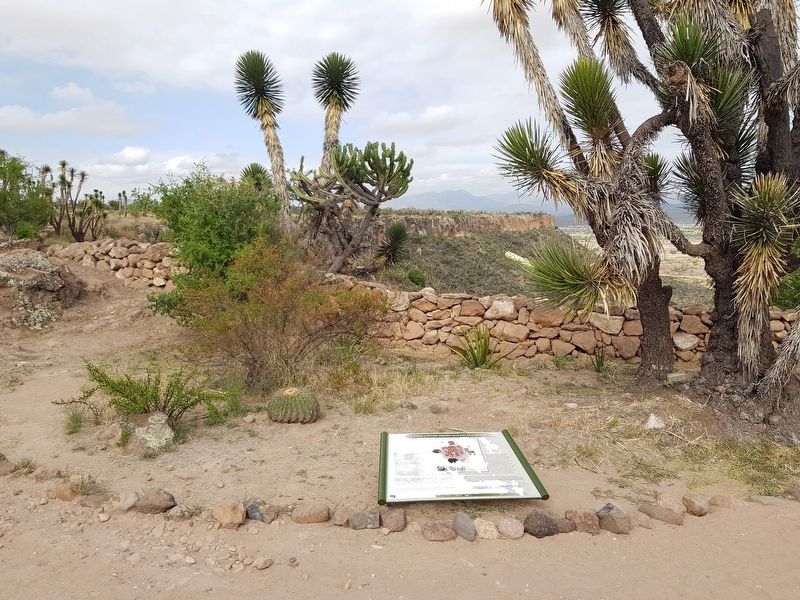La Mesilla in Tecozautla, Hidalgo, Mexico — The Central Highlands (North America)
Sacred plants and animals
Plantas y animales sagrados
En el pensamiento de la cultura Xajay, muchas plantas se consideraban sagradas: el maguey y los sabinos (ahuehuetes) podían servir de comunicación entre los diferentes planos del universo; el maíz, era la representación de Quetzalcoatl, la serpiente emplumada. También, dos tipos de biznaga fueron importantes en la visión del mundo: el Mäkäturu (en Hañhñu), en cuyo interior se fundó la humanidad y el Echinocactus (nombre científico), cactus que - posteriormente - sirvió de modelo para la piedra de los sacrificios entre los aztecas.
Algunos animales también eran sagrados, especialmente el venado, el tlacuache, el oso y el puercoespin, los cuales hoy son considerados como los hermanos mayores de los otomíes y, en la época prehispánica, eran los naguales en los que se transformaba el dios Tezcatlipoca.
La creencia del nagualismo existe hasta la actualidad, y es la capacidad de algunas personas en transformarse en ciertos animales.
Pie de dibujos:
El dios Tezcatlipoca y sus diferentes transformaciones
Biznaga natural y representaciones de biznaga del Códice Boturini
Sacred plants and animals
In the Xajay culture world view many plants were considered sacred: the maguey and the sabine (Montezuma cypress) could serve as communication between the different planes of the universe; the corn was the representation of Quetzalcoatl, the feathered snake. Also, two types of Barrel cactus were important to their world view: the Makaturu (in Hañhñu), inside of which humanity was founded and Echinocactus (scientific name), a cactus that later served as a model for the sacrifice stone of the Aztecs.
Some animals were also sacred; especially deer, opossum, black bear and porcupine, which today are considered the older brothers of the Otomies and, in prehispanic times, were the naguales (sorcerers or wizards) who transformed into the Tezcatlipoca gods.
The belief of the nagualism still exists today, which is the ability of some persons to transform into certain animals.
Captions (English translation):
The deity Tezcatlipoca and his different transformations
A natural barrel cactus and its representations from the Boturini Codex.
Erected by Consejo Nacional para la Cultura y las Artes (CONACULTA) y el Instituto Nacional de Anthropología e Historia (INAH).
Topics. This historical marker is listed in these
topic lists: Animals • Anthropology & Archaeology • Environment • Native Americans. A significant historical year for this entry is 1500.
Location. 20° 30.253′ N, 99° 41.056′ W. Marker is in La Mesilla, Hidalgo, in Tecozautla. Marker can be reached from Entrada del Sitio Arqueológico de Pahñu, on the left when traveling north. Touch for map. Marker is in this post office area: La Mesilla HGO 42460, Mexico. Touch for directions.
Other nearby markers. At least 8 other markers are within walking distance of this marker. The Quincunx and the Ritual Paths (within shouting distance of this marker); Message in the Soil: Geoglyph (within shouting distance of this marker); A Sacred Triangle and the Temple of the Sun (about 90 meters away, measured in a direct line); Pahñu: The Luminous Path (about 90 meters away); Messages in the Rocks: Petroglyphs (about 90 meters away); Circular Altar or Wheel of Sacrifice (Temalácatl) (about 120 meters away); The Calendar on the Landscape (about 120 meters away); The Plaza and the Xiuhtecuhtli Temple (about 150 meters away). Touch for a list and map of all markers in La Mesilla.
Credits. This page was last revised on June 23, 2018. It was originally submitted on June 23, 2018, by J. Makali Bruton of Accra, Ghana. This page has been viewed 151 times since then and 12 times this year. Photos: 1, 2, 3. submitted on June 23, 2018, by J. Makali Bruton of Accra, Ghana.


